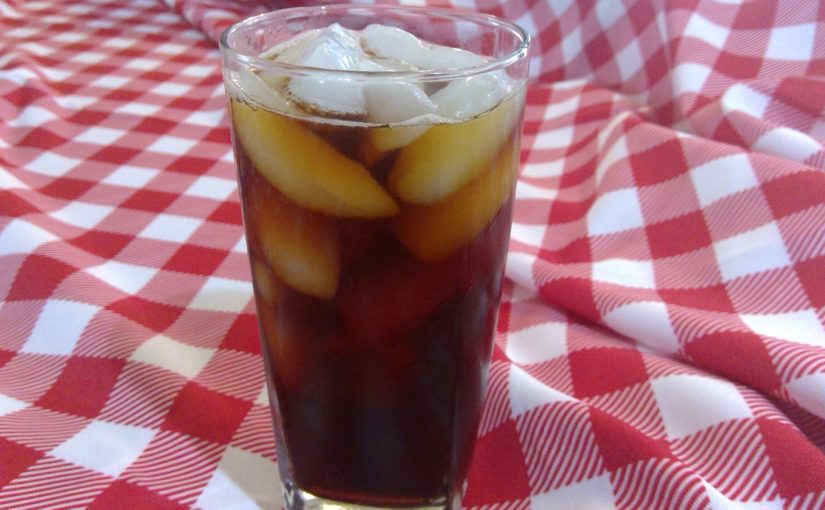Iced Tea can be a healthy drink that can help quench your thirst on a hot summer day. Iced tea can contain caffeine or be decaf, can be sweetened or unsweetened. There are now even different types of iced tea, such as black tea, green tea, or many different types of herbal tea. Unsweetened iced tea is calorie free and contains many antioxidants. Sweet tea can contain up to 180 calories per serving and have different flavors, such as peach, raspberry, blueberry, and many more. So, when choosing tea, it’s best to choose the unsweetened variety.
Hot tea has been around for centuries, but iced tea is relatively new. Iced tea made its first appearance in print in 1879 in the cook book ‘Housekeeping in Old Virginia’.1 In that book the author recommended filling the glass with ice, putting two teaspoons of sugar in the glass, and pouring the green tea over the ice and sugar. Iced tea really became popular after it was featured at the 1904 World’s Fair in St. Louis.
Black tea is what the typical iced tea is made from. Black tea comes from the plant Camellia sinensis plant. It is stronger in flavor and has more caffeine than other teas, but less caffeine than coffee. Black tea offers many health benefits due to the antioxidants that it contains. Black tea contains polyphenols that have antioxidant properties.2 Consuming antioxidants can help decrease the risk of chronic disease and improve overall health. Black tea may also be beneficial for heart health.3 Studies have found that regularly drinking black tea can help reduce the risk of heart disease. There are two types of cholesterol in the blood. LDL cholesterol, which is the ‘bad’ cholesterol and HDL which is known as the ‘good’ cholesterol. Too much cholesterol in the blood can increase the risk of heart disease and stroke. Studies have found that black tea may reduce LDL levels.4,5 Black tea may also help control blood glucose (sugar) levels. Insulin is a hormone that is secreted when you consume sugar. Unsweetened iced tea can help improve the use of insulin and reduce blood glucose levels.6
Green tea has many of the same benefits as black tea. Green tea contains a powerful compound, Epigallocatechin Gallate (EGCG). EGCG is one of the reasons green tea has medicinal properties.7 Green tea has been shown to increase the metabolic rate and increase fat burning,8–10 however not all studies agree with this.11 Green tea may also lower your risk of type 2 diabetes, a disease that has reached epidemic proportions. Green tea has been shown to improve insulin sensitivity and reduce blood glucose levels.12
If you want to try an herbal tea, here are some choices that may be worth trying:
- Peppermint – Most commonly used to relieve discomfort of the digestive tract, but also has antioxidant, anticancer, antibacterial, and antiviral properties.13
- Hibiscus – This tea is made from the colorful flowers of the hibiscus plant. It is usually pink in color and has a tart flavor. Hibiscus tea may help lower blood pressure. It should not be taken with certain diuretic medication or at the same time as asprin.14
- Rooibos – This is an herbal tea that comes from South Africa and is made from the leaves of the rooibos plant. South Africans have used it for medicinal purposes, however few human studies have been conducted. Preliminary evidence suggests that rooibos tea may help improve bone health, but more studies are needed.15
Overall, iced tea rather it be black, green, or herbal all play a part in healthy eating. Just be sure to choose the unsweetened version to keep your consumption of sugar sweetened beverages down. Iced tea is packed with antioxidants which can help lower your risk for heart disease and some cancers, as well as lower LDL cholesterol levels and blood glucose levels.
Enjoy a glass of unsweetened iced tea today!
References
1. History Of Lipton Iced Tea. Lipton. https://www.lipton.com/us/en/our-purpose/the-history-of-lipton-iced-tea.html. Accessed June 26, 2019.
2. Łuczaj W, Skrzydlewska E. Antioxidative properties of black tea. Prev Med (Baltim). 2005;40(6):910-918. doi:10.1016/J.YPMED.2004.10.014
3. Gardner EJ, Ruxton CHS, Leeds AR. Black tea – helpful or harmful? A review of the evidence. Eur J Clin Nutr. 2007;61(1):3-18. doi:10.1038/sj.ejcn.1602489
4. Davies MJ, Judd JT, Baer DJ, et al. Black Tea Consumption Reduces Total and LDL Cholesterol in Mildly Hypercholesterolemic Adults. J Nutr. 2003;133(10):3298S-3302S. doi:10.1093/jn/133.10.3298S
5. Fujita H, Yamagami T. Antihypercholesterolemic effect of Chinese black tea extract in human subjects with borderline hypercholesterolemia. Nutr Res. 2008;28(7):450-456. doi:10.1016/j.nutres.2008.04.005
6. Tang W, Li S, Liu Y, Huang M-T, Ho C-T. Anti-diabetic activity of chemically profiled green tea and black tea extracts in a type 2 diabetes mice model via different mechanisms. J Funct Foods. 2013;5(4):1784-1793. doi:10.1016/J.JFF.2013.08.007
7. Eng QY, Thanikachalam PV, Ramamurthy S. Molecular understanding of Epigallocatechin gallate (EGCG) in cardiovascular and metabolic diseases. J Ethnopharmacol. 2018;210:296-310. doi:10.1016/j.jep.2017.08.035
8. Venables MC, Hulston CJ, Cox HR, Jeukendrup AE. Green tea extract ingestion, fat oxidation, and glucose tolerance in healthy humans. Am J Clin Nutr. 2008;87(3):778-784. doi:10.1093/ajcn/87.3.778
9. Dulloo AG, Duret C, Rohrer D, et al. Efficacy of a green tea extract rich in catechin polyphenols and caffeine in increasing 24-h energy expenditure and fat oxidation in humans. Am J Clin Nutr. 1999;70(6):1040-1045. doi:10.1093/ajcn/70.6.1040
10. Diepvens K, Westerterp KR, Westerterp-Plantenga MS. Obesity and thermogenesis related to the consumption of caffeine, ephedrine, capsaicin, and green tea. Am J Physiol Integr Comp Physiol. 2007;292(1):R77-R85. doi:10.1152/ajpregu.00832.2005
11. Gregersen NT, Bitz C, Krog-Mikkelsen I, et al. Effect of moderate intakes of different tea catechins and caffeine on acute measures of energy metabolism under sedentary conditions. Br J Nutr. 2009;102(8):1187-1194. doi:10.1017/S0007114509371779
12. Liu K, Zhou R, Wang B, et al. Effect of green tea on glucose control and insulin sensitivity: a meta-analysis of 17 randomized controlled trials. Am J Clin Nutr. 2013;98(2):340-348. doi:10.3945/ajcn.112.052746
13. McKay DL, Blumberg JB. A review of the bioactivity and potential health benefits of peppermint tea (Mentha piperita L.). Phyther Res. 2006;20(8):619-633. doi:10.1002/ptr.1936
14. Hopkins AL, Lamm MG, Funk JL, Ritenbaugh C. Hibiscus sabdariffa L. in the treatment of hypertension and hyperlipidemia: A comprehensive review of animal and human studies. Fitoterapia. 2013;85:84-94. doi:10.1016/j.fitote.2013.01.003
15. Nash LA, Ward WE. Comparison of black, green and rooibos tea on osteoblast activity. Food Funct. 2016;7(2):1166-1175. doi:10.1039/c5fo01222h

